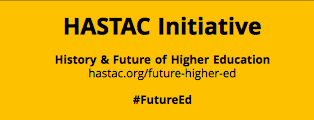 The main purpose of Cathy Davidson’s The History of Future of (Mostly) Higher Education (taught in the Coursera platform) was to think about how to redesign higher education to meet 21st century learning goals. Professor Davidson has a track record of innovation in education; she co-founded the influential HASTAC organization, which is dedicated to increasing student engagement in learning. In this tradition, she framed her MOOC as a movement across universities and institutions, rather than a single course, and went above and beyond to encourage online student interactions beyond the traditional model of forum contributions. Below are some highlights of her experimental approach to teaching a MOOC and the lessons her students took away from the experience.
The main purpose of Cathy Davidson’s The History of Future of (Mostly) Higher Education (taught in the Coursera platform) was to think about how to redesign higher education to meet 21st century learning goals. Professor Davidson has a track record of innovation in education; she co-founded the influential HASTAC organization, which is dedicated to increasing student engagement in learning. In this tradition, she framed her MOOC as a movement across universities and institutions, rather than a single course, and went above and beyond to encourage online student interactions beyond the traditional model of forum contributions. Below are some highlights of her experimental approach to teaching a MOOC and the lessons her students took away from the experience.
Be a skeptic of the medium. Professor Davidson was openly critical of the way content is presented in massive open online courses. Most information is delivered by lecture and multiple choice quizzes are sometimes the only form of testing. This developed partly out of necessity — videos are the easiest way to communicate online and similarly testing discrete knowledge, when teaching thousands of students, is the most practical solution to assessment. However, it is also a reflection of the academy’s lingering perception of the lecture being the best way to deliver content to students. As Professor Davidson points out, this teacher-centered approach to knowledge is a disservice to a class that strives to increase critical thought about education and foster student empowerment. Her honesty about her issues with the delivery of the course content encouraged her students to reflect on the ways in which they get their information, the nature of the lecture, and what kind of assessment are meaningful and when. As one student explained, “this course was a well-intentioned effort that seemed to run smack into the limitations of the MOOC format…”
Seek out other perspectives and networks. The Coursera MOOC was only one component of the larger HASTAC #FutureEd Initiative. This was an invitation to anyone interested in transforming higher education to contribute resources, share pedagogical innovations, hold events, and use the MOOC content in their own courses. The call was answered by instructors, graduate students, and academic administrators from around the world. While teaching the MOOC, Cathy Davidson also collaborated with colleagues from Stanford University and University of California Santa Barbara to teach connected #FutureEd classes on their own campuses. The students in Duke’s History and Future of Higher Education served as community leaders in the MOOC course. They held online office hours, responded to content questions in the forums, and wrote reflective blog posts for The Chronicle of Higher Education‘s FutureEd series. Davidson’s it-takes-a-village approach to solving the issues facing higher education modeled her belief that learning in the 21st century must be connected and collaborative. The MOOC students did not limit their interactions to Coursera; they took it upon themselves to create virtual study groups and Twitter had a steady stream of backchannel conversations.
Take charge of your own learning. To increase student engagement, Professor Davidson created assignments in the MOOC that moved beyond the typical online forum discussion questions. Students were encouraged to create their own texts; for example, they worked on a course constitution to decide on the rules of conduct and intent of the online course. During a week discussing the roots of higher education, the international audience was  invited to add seminal dates in the history of education in their country to a course wiki. One student was inspired to contribute mind maps of the weekly content to the course wiki. The design of formal assessments were also meant to generate student content, instead of reiterating the information in the videos. The final peer assessment asked students to describe their vision of a modern university. The point was made–education needs to be responsive to learner’s goals, make sense in the connected, Internet world of today, and students need the tools to write their own path in learning.
invited to add seminal dates in the history of education in their country to a course wiki. One student was inspired to contribute mind maps of the weekly content to the course wiki. The design of formal assessments were also meant to generate student content, instead of reiterating the information in the videos. The final peer assessment asked students to describe their vision of a modern university. The point was made–education needs to be responsive to learner’s goals, make sense in the connected, Internet world of today, and students need the tools to write their own path in learning.
